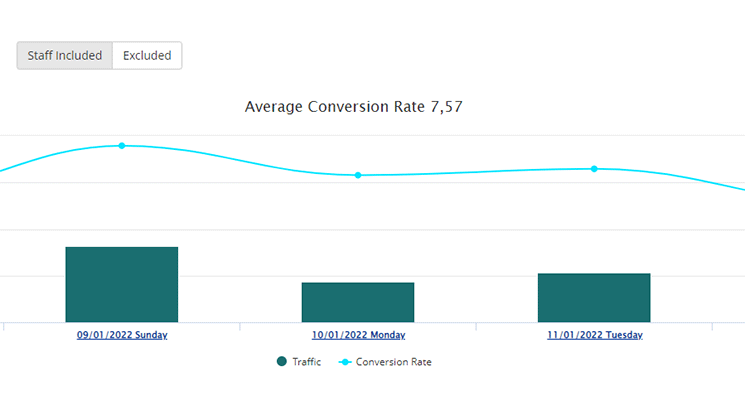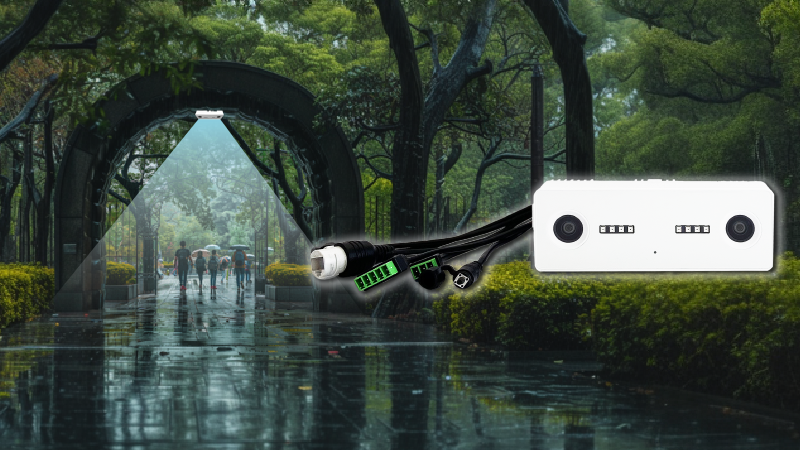Measuring footfall traffic numbers for brick and mortar businesses is one of the most fundamental metrics to consider when measuring business success. However, visitor traffic numbers can be easily distorted when staff members are included in the count, resulting in inaccurate conversion rates.
Accurate and pure people counting data is essential to understanding the number of shoppers coming into retail stores, how they behave, and how to improve customer satisfaction, and as a result, boost sales.
What is Staff Exclusion & How does it Work?
Staff members make up a good portion of the total traffic in the retail industry setting. Throughout the day, staff members come and go at different times for their shifts, lunch breaks, setting up, and closing – distinguishing customers from the staff is key to sensible store analytics.
The V-Count staff exclusion solution is a vision-based technology that anonymously detects and excludes staff traffic from the total in/out visitor count to obtain accurate data and actual conversion rates. Excluding staff data from the overall visitor traffic count is not only specific to retail; it can also be applied to other businesses like libraries, museums, gyms, and universities, just to name a few.

How Ultima AI Operates Staff Exclusion?
The Ultima AI sensor counts people as they enter and exit and excludes staff traffic from the total count. V-Count provides staff QR tags. The tags come with a magnetic clip to attach to the chest area. The tag includes space for name stickers or can be written by hand. The Ultima AI recognizes and counts the QR tags as staff. The data is then sent to our business intelligence platform where staff numbers are excluded from the customer count. The reports capability also allows store managers to prepare and download traffic reports with excluded staff.
Benefits of The Employee Exclusion Solution
High Footfall Traffic Data Accuracy
Exclude your staff count from your overall visitor traffic to get accurate conversion rate data and make fact-based decisions.
Customer-to-Staff Ratio Measurement & Optimization
The usual practice for store managers is to employ several staff members that they estimate will be enough to run the store. This approach could lead to one of two problems. One, they don’t employ enough staff and struggle to provide optimal service to customers during rush hours, which leads to an increase in cart abandonment, lost sales opportunities, and many unhappy customers. Two, in order to ensure that there are enough attendants no matter how busy things get, the store employs too many people. They end up with an inflated budget and many idle employees during slow periods.
Customer traffic data provides an excellent basis for employing and deploying staff efficiently. When historical data is analyzed using AI algorithms, the reports tell managers how many attendants will be required to run the store optimally. Since the analyzed data covers low and high customer traffic periods, under or overstaffing is avoided. Furthermore, computer-generated schedules are used to deploy staff based on traffic patterns. This ensures that enough attendants will be on the floor for all present customers for every shift.
Employee Performance Optimization
Sales attendants are often given backroom duties like receiving shipments, processing inventory, restocking shelves, etc. If these duties interfere with the selling process, they distract the attendant, affect their service delivery, and decrease sales. Attendants on the sales floor must always focus on providing customers with the best service possible.
When backroom operations are needed, the ideal option would be to wait for slow periods to complete them. Traffic data can be analyzed to determine when the store is least active, and secondary duties can be scheduled for these periods.
Closing tasks have also been known to lead to lost sales opportunities. Store managers should check their customer data and conversion rates in the last hour of business days. If the numbers show fewer visits and fewer sales, it may indicate the quality of customer service in that period. If you perform closing tasks while customers are still in your store, you interfere with the selling process.
Personal Development of Staff
Happy employees make happy customers, and using employee scheduling combined with traffic counters can help you figure out a downtime during the day that could be used to train your employees to take on new tasks. This approach will make employees feel like part of a team that values their career growth.








